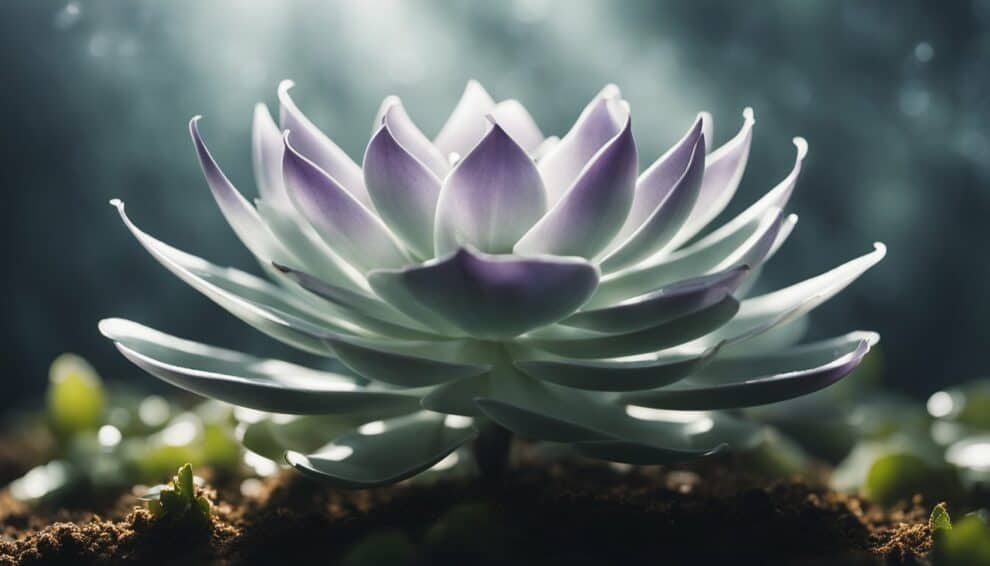Ghost plants, also known as Graptopetalum paraguayense, are a type of succulent that have become increasingly popular in recent years. These plants are known for their unique and ghostly appearance, with leaves that range in color from pale blue to lavender-gray. Ghost plants are easy to care for, making them a great choice for beginners, and they can be propagated easily to create new plants.

Propagation is the process of creating new plants from existing ones, and it is a popular way to expand a collection of ghost plants. There are several methods of propagation, including leaf cuttings, stem cuttings, and division. Each method has its own advantages and disadvantages, but all are relatively simple and can be done by anyone with a bit of patience and a willingness to experiment.
In this article, we will explore the different methods of ghost plant propagation, as well as some tips and tricks for ensuring success. Whether you are a seasoned gardener or a beginner just starting out, this guide will provide you with all the information you need to propagate your own ghost plants and enjoy their ghostly beauty for years to come.
Understanding Ghost Plants
Botanical Profile
Ghost plants, also known as Graptopetalum paraguayense, are succulent plants that are native to Mexico and parts of South America. These plants are known for their ghostly appearance, which is characterized by their pale blue-green leaves that can appear almost translucent. Ghost plants are part of the Crassulaceae family, which includes other popular succulent plants such as jade plants and echeverias.
Ghost plants are small, compact plants that typically grow to be about 6 inches tall and 12 inches wide. They have thick, fleshy leaves that grow in rosettes, with the leaves often arranged in a spiral pattern. Ghost plants produce small, star-shaped flowers that bloom in the summer months, although they are primarily grown for their unique foliage.
Unique Characteristics
One of the most unique characteristics of ghost plants is their ability to change color depending on the amount of sunlight they receive. When grown in bright, direct sunlight, the leaves of ghost plants can take on a pink or reddish hue, while plants grown in partial shade will have a more blue-green color. Ghost plants are also able to tolerate a wide range of temperatures, making them a popular choice for indoor and outdoor gardens.
Ghost plants are relatively easy to care for and can be propagated through stem or leaf cuttings. They prefer well-draining soil and should be watered sparingly, as overwatering can lead to root rot. These plants are also able to tolerate drought conditions, making them a great choice for those who may forget to water their plants regularly.
Overall, ghost plants are a unique and beautiful addition to any succulent collection. Their ghostly appearance and easy care make them a popular choice for both novice and experienced gardeners alike.
Propagation Basics

Ideal Conditions
Ghost plants are easy to propagate, making them a popular choice for gardeners. The ideal conditions for propagating ghost plants include a well-draining soil mix, bright but indirect light, and temperatures between 60-75°F (15-24°C).
It’s important to note that ghost plants are susceptible to root rot, so it’s crucial to avoid overwatering and to ensure that the soil is not too wet.
Propagation Timing
The best time to propagate ghost plants is during the spring and summer months when the plant is actively growing. Propagation can be done through stem cuttings or leaf cuttings.
Stem cuttings should be taken from the top of the plant and allowed to dry for a few days before being planted in soil. Leaf cuttings can be taken from the bottom leaves of the plant and should also be allowed to dry before being planted.
Overall, propagating ghost plants is a simple and rewarding process that can be done by gardeners of any skill level. With the right conditions and timing, ghost plants can quickly produce new growth and add a touch of ghostly beauty to any garden.
Propagation Methods

Leaf Propagation
One of the easiest methods of propagating Graptopetalum paraguayense is by using leaf cuttings. Simply remove a healthy leaf from the mother plant and let it dry for a few days until the cut end calluses over. Then, place the leaf on top of well-draining soil and mist it regularly. After a few weeks, new roots and tiny rosettes will begin to form at the base of the leaf.
Stem Cuttings
Another method of propagating ghost plants is by using stem cuttings. Cut a healthy stem from the mother plant and let it dry for a few days until the cut end calluses over. Then, plant the stem cutting in well-draining soil and mist it regularly. After a few weeks, new roots and tiny rosettes will begin to form at the base of the stem.
Offsets Division
Graptopetalum paraguayense also produces offsets, which can be separated from the mother plant and replanted to create new plants. Simply remove the offset from the mother plant and let it dry for a few days until the cut end calluses over. Then, plant the offset in well-draining soil and mist it regularly. After a few weeks, new roots and a new rosette will begin to form.
Using any of these propagation methods, one can easily create new ghost plants and expand their collection. It is important to note that it may take some time for the new plants to fully establish and grow, but with proper care and attention, they will thrive.
Aftercare and Growth

Post-Propagation Care
Once the Ghost Plant cuttings have rooted, it is time to transplant them into their individual containers. Make sure to use a well-draining soil mix and a container with drainage holes. The plant should be watered thoroughly after transplanting, and then watered again only when the soil is completely dry.
Ghost Plants prefer bright, indirect light, so it is important to place them in a location where they can receive adequate light without being exposed to direct sunlight. If the plant is not receiving enough light, its leaves may become stretched out and lose their vibrant color.
Fertilizing the Ghost Plant is not necessary, but if desired, a balanced fertilizer can be applied every few months during the growing season. Be sure to follow the instructions on the fertilizer package and avoid over-fertilizing, as this can damage the plant.
Common Challenges
One of the most common challenges when caring for Ghost Plants is overwatering. These plants are susceptible to root rot, so it is important to allow the soil to dry out completely between waterings.
Another challenge is pests such as mealybugs and spider mites. If these pests are present, they can be treated with an insecticidal soap or neem oil. It is important to catch and treat pest problems early to prevent them from spreading and causing damage to the plant.
Finally, Ghost Plants can become leggy if they do not receive enough light. If this occurs, the plant can be pruned back to encourage new growth and a more compact shape. Overall, with proper care and attention, Ghost Plants can thrive and provide a beautiful addition to any indoor or outdoor garden.
Frequently Asked Questions

What are the steps to propagate Graptopetalum paraguayense in water?
To propagate Graptopetalum paraguayense in water, start by taking a healthy leaf cutting from the mother plant. Allow the cutting to dry for a few days until a callus forms. Then, place the cutting in a jar of water, making sure that the bottom of the cutting is submerged. Change the water every few days and keep the jar in a bright, indirect light. After a few weeks, roots should start to form, and you can transplant the cutting into soil.
How can I successfully propagate ghost plant leaves?
To propagate ghost plant leaves, gently twist a healthy leaf from the mother plant, being careful not to damage the stem. Allow the leaf to dry for a few days until a callus forms. Then, place the leaf on top of well-draining soil and mist it lightly with water. Keep the soil moist and the leaf in bright, indirect light. After a few weeks, new roots should start to form, and a new plant will emerge.
What care should be taken after propagating a ghost plant?
After propagating a ghost plant, it is important to keep the new plant in a bright, indirect light and to water it sparingly until it becomes established. Once the new plant has rooted and begun to grow, you can treat it like a mature ghost plant and water it more frequently, but always allow the soil to dry out between waterings.
Can you explain how ghost plants reproduce?
Ghost plants reproduce through a process called vegetative propagation, where a new plant is grown from a leaf or stem cutting of the mother plant. This allows the new plant to be genetically identical to the mother plant, ensuring that it will have the same characteristics and traits.
What are the benefits of having a ghost plant?
Ghost plants are a popular choice for indoor and outdoor gardens because of their unique, ghostly appearance and ease of care. They are drought-tolerant and can be grown in a variety of conditions, making them a great choice for beginners or experienced gardeners.
What is the best method to transplant a ghost plant?
When transplanting a ghost plant, it is important to choose a pot that is slightly larger than the current one and has good drainage. Gently remove the plant from its current pot and loosen any tangled roots. Place the plant in the new pot and fill in around it with fresh soil, making sure to press down firmly to eliminate air pockets. Water the plant thoroughly and allow the soil to dry out before watering again.













